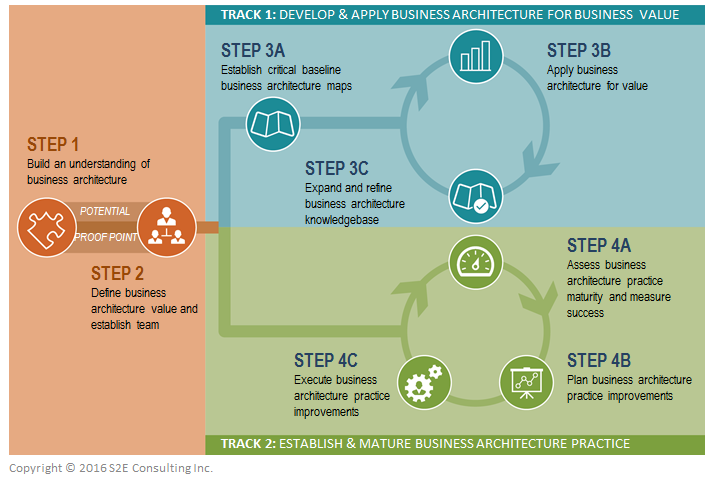Once business architecture gains enough traction within an organization, it is important to formalize the practice. Having clarity of purpose, structure and intention for business architecture activities ensures that the team functions efficiently, is appropriately recognized, and can scale to meet the needs of the organization.
As a business architecture practice matures, the value it can deliver increases in strategic nature, scope and complexity. Establishing a successful, sustainable business architecture practice is a journey which takes time, particularly for large organizations. This article provides a practical perspective on how to establish and mature a practice over time considering the realities which many organizations face.
A Common Reality
The catalyst for starting a business architecture practice is most often a passionate practitioner or manager within the organization, or a small group of them. If this is your situation, you are not alone. As the discipline continues to mature globally though, there will be a more foundational understanding of business architecture, not just by practitioners, but in board rooms and universities as well. This will eventually make the business architect’s job easier so they can focus more on doing the work and less on justifying the value and proving how it is different than other disciplines.
Considering the current context, the reality for most practitioners is that they have to start where they can start, even if it means their reporting structure, focus areas or time allocation is not ideal in the beginning. They also frequently have to not only build the baseline business architecture, but also start using it to demonstrate value as quickly as possible (a sort of “building while in flight” approach). These realities and ways to address them while still staying true to business architecture principles are reflected in the roadmap below.
Roadmap to Establish a Business Architecture Practice
The roadmap below provides a practical, proven approach to establish and mature a business architecture practice. It incorporates three key aspects that must occur in harmony with each other on an ongoing basis:
- Developing and maintaining the business architecture knowledgebase
- Applying business architecture for value (the most important!)
- Establishing and maturing the business architecture practice foundation

The first two steps of the roadmap provide a critical foundation for all of the remaining ones. In Step 1, the initial business architecture champion(s) and practitioners build an understanding of business architecture, including what it is, the value it provides and how it fits with the rest of the organization. In Step 2, the value and usage of business architecture specific to the organization is defined and the team is established. The value of business architecture must be clearly, simply and consistently articulated to all stakeholders, including the business architecture team itself as it will guide their activities, decisions and priorities.
Some organizations need additional time to prove the value of business architecture and gain support before they move onto Step 2, as shown by the Potential Proof Point. During this time, some basic baseline business architecture maps may be developed (though not in full detail), and then applied to an initial scenario or two. During this proving period, it is important to:
- Develop any business architecture maps from an enterprise and long-term usage perspective
- Select scenarios which will demonstrate the true value of business architecture (e.g. a cross-business unit opportunity)
- Execute on the scenarios quickly and successfully
- Share stories and results to build advocacy
After Step 2, the roadmap continues along two parallel tracks. The first track (the primary one) is for developing the business architecture knowledgebase and applying business architecture for value. The loop within this track will continue indefinitely, though the applications for business architecture typically grow in scope and complexity over time. The second track is for establishing and maturing the business architecture practice, which includes all supporting aspects such as developing people, managing methods and practices, maintaining tools, integrating into the organization and measuring success. This loop will also continue indefinitely, but once a practice reaches a state of desired maturity, the focus becomes more on continuous improvement versus significant advancements.
Within Track 1, Step 3A establishes critical baseline business architecture maps, such as an enterprise capability map, an information map and core value streams. Of course the entire business architecture baseline can and would ideally be mapped up front, but this is not always feasible for some organizations for various reasons. Business architecture is then put into action quickly in Step 3B in order to start providing business value. Step 3C continually builds the business architecture baseline by expanding on the current maps and adding new types of maps, such as for strategies, products and initiatives. It also refines the content of the entire knowledgebase as needed on an ongoing basis. The expansion activities in Step 3C are typically prioritized based on the types of scenarios in which business architecture will be applied during Step 3B, particularly in the case of a new practice where limited resources are available.
Within Track 2, there is a continual loop for maturing the business architecture practice, starting with Step 4A which provides an assessment of the current practice maturity and measurement of its success. In conjunction with practice goal-setting, this leads to Step 4B, which plans enhancements for the practice during the next horizon. Step 4C executes on the planned enhancements, which are measured again in Step 4A. This loop typically occurs as an annual planning rhythm where the measurement, goal-setting and next horizon planning for the business architecture practice is done at the end of the year, and then practice enhancements are executed during the following year. All planned practice enhancements should be directly aligned with how business architecture is being applied in Step 3B. The most practical approach to establishing and scaling a practice is to do just enough, just in time to support the current business architecture scenarios.
In Summary
Establishing a business architecture practice requires activities to be performed along two parallel tracks: developing and applying business architecture and maturing the supporting practice foundation. The intended value of business architecture should guide the team’s activities, decisions and priorities, including the knowledgebase domains to focus on and the scenarios in which to apply business architecture. Supporting practice foundation activities should be carried out in a “just enough” and “just in time” manner to support the relevant business architecture scenarios at the time.
Organizations who commit to and invest in their business architecture practices will know they have succeeded when the discipline is valued and expected within strategic, planning and solution development activities across the enterprise – and embedded into the very fabric of the organization.

















